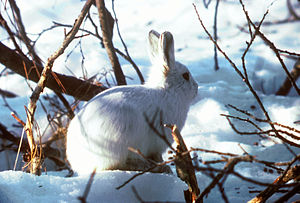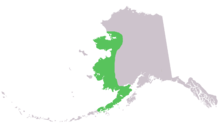Alaska hare
| Alaska hare | ||||||||||||
|---|---|---|---|---|---|---|---|---|---|---|---|---|

Alaska hare ( Lepus othus ) |
||||||||||||
| Systematics | ||||||||||||
|
||||||||||||
| Scientific name | ||||||||||||
| Lepus othus | ||||||||||||
| Merriam , 1900 |
The Alaska hare ( Lepus othus ) is a species of mammal belonging to the genus of the real hare within the lagoon group . Its range is limited to western Alaska .
features
The Alaska hare is the largest species of hare in North America and reaches a body length of 50 to 70 centimeters with a tail length of about 8 centimeters. The rear feet are very long at around 20 centimeters and enable locomotion on snow . There is no sexual dimorphism . The body color shows a seasonal dimorphism : In summer the animals have a gray-brown upper coat and a white undercoat, while in winter they develop a completely white coat. The only exception is the black tip of the ears, which is present all year round. Young animals are born in summer and are slightly darker than the adult animals.
The head of the animal is robustly built and the upper incisors are very strongly curved. Unlike most other rabbit species, Alaska rabbits have relatively short ears in order to minimize heat loss. The claws are short and allow digging in the snow.
distribution
The distribution area of the Alaska hare is limited to the west and southwest of Alaska , United States . The hare occurs at altitudes of up to 660 meters. Until a few years ago, it was also assumed that it was spreading on the Chukchi Peninsula , Russia . However, according to molecular biological studies, the populations there are more closely related to the mountain hare ( Lepus timidus ).
The habitat of the Alaska hare is characterized by stony slopes and the open tundra , mostly at higher altitudes.
Way of life
The animals are primarily crepuscular and therefore active in the evening and in the morning and in search of food. With the exception of the mating season, they are solitary animals.
nutrition
Alaska hares, like other hares in the arctic regions, feed on woody and green parts of plants from dwarf willows, grasses, sedges and heather plants of the tundra. They eat branches, saplings, bark and roots of the plants. They also eat green grasses, berries and also flowers when these are available.
Reproduction
The mating season of the Alaska hares is from April to May. During this time they form groups of 20 or more animals. The gestation period is around 46 days and, unlike other rabbit species, the females only give birth once a year, in the summer from June to July. The litter size is four to eight, on average five to six, young animals. These are born in open nests above ground with a full coat of fur and open eyes as fleeing nests , so they are active immediately after birth.
Systematics
The Alaska hare is assigned to the real hare (genus Lepus ) as an independent species . However, the species status was sometimes questioned and a merger with the polar hare ( Lepus arcticus ) or the mountain hare ( Lepus timidus ), who are considered to be closest relatives, was proposed.
Hazard and protection
The species is rated by the International Union for Conservation of Nature and Natural Resources (IUCN) as “Least Concern” due to the size of the population. A decline in the population and a greater threat are not known, but there are only a few research reports on the species.
supporting documents
- ↑ a b c d e f g Lisa DeBruine: Lepus othus in the Animal Diversity Web of the University of Michigan Museum of Zoology. Retrieved January 14, 2012.
- ^ Troy L. Best , Travis Hill Henry: Lepus othus . In: Mammalian Species . No. 458 , 1994, p. 1–5 ( full text (PDF; 640 kB)).
- ↑ a b c d Lepus othus in the endangered Red List species the IUCN 2011. Posted by: D. Murray, AT Smith, 2008. Accessed January 14, 2012 Design.
literature
- Troy L. Best , Travis Hill Henry: Lepus othus . In: Mammalian Species . No. 458 , 1994, p. 1–5 ( full text (PDF; 640 kB)).
Web links
- Lepus othus in the endangered Red List species the IUCN 2011. Posted by: D. Murray, AT Smith, 2008. Accessed January 14, 2012 Design.
- Lisa DeBruine: Lepus othus in the Animal Diversity Web of the University of Michigan Museum of Zoology. Retrieved January 14, 2012.
